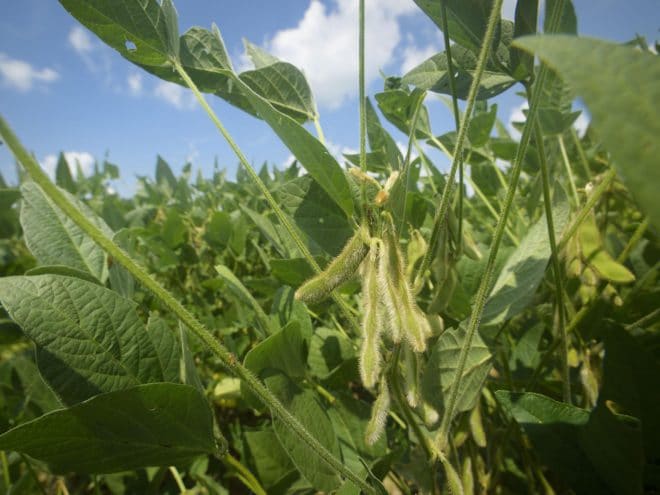STARKVILLE, Miss. — Most of the state’s soybean crop has a very good yield potential despite some challenges coming late in the season.
Trent Irby, soybean specialist with the Mississippi State University Extension Service, said growers planted more than 60 percent of the crop in April.
According to last year’s crop report, soybeans produced over a billion dollars in value.
“We had more soybeans planted in April than we’ve had in years,” Irby said. “We had several windows that month where it was warmer than usual and dry enough to plant, and growers took advantage of those planting opportunities.”
This early planting date is an advantage on many acres, as the crop has the potential to avoid times when it is vulnerable to certain diseases and insect pests common at this time of year.
The U.S. Department of Agriculture estimated that 90 percent of the crop was blooming and 76 percent was setting pods by July 23. Those figures are well ahead of the five-year average, and the overall crop condition is rated as 70 percent fair or good and 22 percent excellent.
Irby said disease pressure has been manageable to this point in the year, although growers are concerned about target spot, which was a problem in 2016.
“So far, disease issues haven’t been out of the norm in Mississippi,” Irby said. “A lot of that is environment-dependent. We had a lot of rain and lower than normal temperatures in June, but disease pressures remained relatively light during that period. July has been much warmer with more scattered rains, but we still need to pay close attention for any disease development moving forward, particularly on the later planted part of the crop.”
Angus Catchot, Extension entomologist, said Mississippi soybean growers are dealing with two insects, but which pest is a problem depends on when the crop was planted.
“Corn earworms or bollworms are a problem now in later planted soybeans, and redbanded stinkbugs are a problem in earlier planted soybeans, mostly in the southern part of the state,” Catchot said.
Most of the state’s soybeans were planted early and will miss the bollworm problem. Later planted soybeans in the Delta are flowering and are susceptible to this pest, but Catchot said growers have bollworms under control.
Redbanded stinkbugs are another issue.
“Redbanded stinkbugs are a lot more difficult to control and more damaging than our traditional stinkbugs,” he said. “Particularly south of Highway 82, we have a lot of redbanded stinkbugs in our system that are being treated.”
When the early-planted soybeans mature and begin to dry down, late-planted soybeans are among the only green plants left on cropland.
“I’m anticipating we’ll have a lot more pressure from redbanded stinkbugs then,” Catchot said. “We need to make sure we’re on top of scouting for these pests in the coming weeks.”
The other challenge facing this year’s soybean crop is off-target movement of dicamba, an herbicide applied to resistant crops that can volatize, or become airborne, and drift away in a vapor. This problem can damage other nearby crops not resistant to dicamba.
“There are concentrations of this herbicide that may not cause a yield reduction, and there are concentrations that will,” Irby said. “Without knowing the concentration, there’s no way to know what the potential impact on yield will be on the affected acres.”
Growers who suspect there is an off-target movement issue in their fields are encouraged to contact the Bureau of Plant Industry in the Mississippi Department of Agriculture and Commerce.
Information provided by the Mississippi State University Extension Service.




